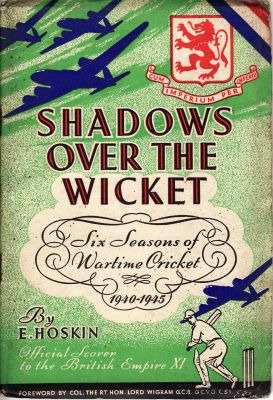Shadows Over The Wicket, Six Seasons of Wartime Cricket 1940-1945
David Kelly |Published: 1946
Pages: 76
Author: Hoskin, E
Publisher: John Jennings (Gloucester) Ltd
Rating: 4.5 stars

It all started with the idea of Desmond Donnelly to organize a cricket match in 1940 to benefit the Red Cross. That the team he put together, the British Empire XI, carried on for five more seasons and raised £15,000 (well over half a million in today’s money) almost completely for that worthy cause is testament not only to Donnelly – then aged 19 and later to become a Labour, and afterwards an Independent, politician – but to the framework he passed on after two years at the secretarial helm. People like Leo Bennett, Ray Smith, Stanley Rous and the team’s President throughout the six seasons, Sir Pelham Warner, contributed immensely to the management and success of the team.
This book by Ernest Hoskin, the scorer to the XI, records great performances, gives the seasonal averages and summarizes the on-field activities of the team in a most interesting and entertaining fashion, either to be read through or to be dipped into. There are no detailed match scores but there are dozens of memories, snippets, performances, statistics …
After a ground-setting Foreword by Col The Right Hon Lord Wigram, Chairman of the Red Cross Sports Committee, the beneficiary charity of the XI, Hoskin’s own Introduction incorporates short biographical notes of the two leading players in the XI’s history, Ray Smith, the Essex all-rounder who captained the team for most its tenure, and Dr Bertie Clarke, the West Indian leg-spinner, who captured more than twice the number of wickets as any other bowler.
And, after that, Hoskin gives an overall review of what he frequently referred to as the ‘touring’ side, its first match, the changes when Donnelly joined the RAF, the popularity of Ray Smith, the generosity of the public in supporting the charity, the support of Norman Preston with all the press coverage he achieved for the XI. Well-known players who appeared take up a full page of this 76-page booklet – Badcock, Bailey, two Bedsers and two Comptons, Constantine, Dempster, Ernest Eytle (later Worrell’s biographer), Fagg, Hendren, Hopper Levett, Miller, Wyatt, Yardley, among very many.
Hoskin is good on his personalities and his memories of so many games: double century stands; close finishes; players loaned by opposing clubs; centuries for and against; matches at “Lords” [sic]; a tribute to the late Maurice Spearing, a victim of enemy action. And there are a few well-presented photographs.
There is much, deservedly so, on the Farewell Dinner in September 1945. Among the many guests were Lord Wigram; Warner and Rous; Norman Preston and Reg Hayter for the press; Mr E J B Spearing, the late Maurice’s father; very many British Empire XI players and representatives from opposing teams; Mr E Fletcher, the regular umpire for the XI for four seasons; the author himself; and notably Desmond Donnelly, the man who started it all.
The purpose of the British Empire XI – similar to the London Counties team with which it had a friendly rivalry, especially in the first season – was to raise funds for charity but also to maintain public morale by providing cricketing entertainment. The team played 243 matches across the six seasons, essentially in southern England, especially in Surrey, but with regular forays to Coventry in particular, Trent Bridge and other venues in the Midlands, Cardiff and Southampton.
The book is very nicely produced, the only criticism being the slightly stiffened covers overlapping the text pages by 8mm on the open side and 4mm at top and bottom. The resulting ‘skirt’ therefore is apt to crease and wear extremely easily.
This immediate post-war offering loses half a mark because of the rather irritating “Lords” throughout instead of “Lord’s”, astonishing really given the involvement of ‘Plum’ Warner. But it gains half a mark at least because of its excellent cover, courtesy of “the lady who so generously and skilfully painted” it. This display of anonymity in the author’s Introduction is balanced by her signature that can just be made out in the bottom corner of the cover, reading what appears ‘E R Donovan’.
Overall, Ernest Hoskin’s only permanent contribution to cricket’s literature is valuable, interesting and fills a void in a very readable manner.




Leave a comment